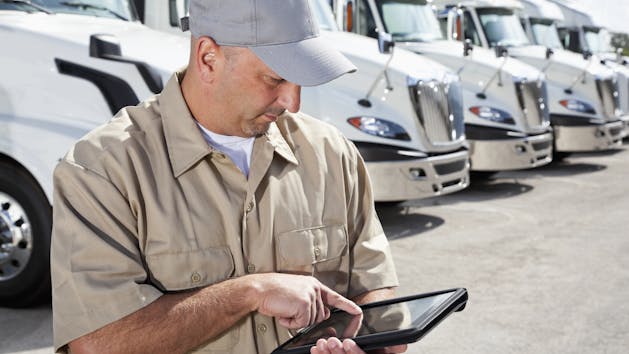Find the right solution for your business with our free Fleet Management Buyer’s Guide.
5 Tips to Help Drivers Transition to Electronic Logs
With the publishing of the final rule in December 2015, drivers who record their Hours of Service (HOS)* will need to find and implement an Electronic Logging Device (ELD) prior to the deadline.
While the change has been welcomed by the ATA and lawmakers who feel that paper logs have been proven to be less accurate and easy to manipulate, some drivers are not so enthusiastic, fearing an invasion of privacy and ‘big brother’ management.
Regardless of where your drivers stand on the issue, everyone will have to be compliant. If you’re looking for ways you can help your drivers adapt to the ELD change, check out the five things that could have your teams changing their point of view and welcoming the necessary transition to all things digital.
But first...be patient.It’s important to remember that change is difficult for everyone, even when the change itself is positive. There may be some grumbling, some reminiscing about the good old days and a few comments about technology taking over but often those complaints are triggered by the hassle of learning something new. Stick with it, be patient with your drivers and in time they’ll see it’s not as bad as maybe they imagined it was. It’s likely they’ll even start appreciating the benefits of ditching paperwork.
1. Get educated
We’re not saying you need to read all 126 pages of the ELD final rule but it’s good to get a grasp of the basics.
A good place to start is to browse our ELD blog posts, which cover some of the more popular questions as well as a few more of the brass-tack details like who’s exempt, can the logs be edited and whether violations are automatically reported to the DOT.
Being informed about what the new legislation requires, how the technology works and what it will mean for your employees - or at least know where you can go to get reliable, up-to-date answers - will help you ease any concerns drivers might have.
For example, the rule states that for the purpose of recording HOS, location accuracy is limited to a 1-mile radius while on duty, and a 10-mile radius during personal time, with updates reported only once every 60 minutes (see 78296 Federal Register / Vol. 80, No. 241).
There are also specific provisions to prevent use of the technology to harass drivers, and legislated procedures for drivers who feel these guidelines have been overstepped by their employer. Making sure that ELDs can be muted while the driver is sleeping, is one example of preventing harassment.
If you have any specific questions not already covered, feel free to contact us for assistance.
2. Communicate openly
During this transition phase it’s important to make sure everyone is kept well-informed about what’s changing and why. Employees are often sensitive to talk of change and rumors can run rampant through the company grapevine - early intervention is key.
Take the time to explain exactly what an ELD is, and what it isn’t. Unfortunately there are a lot of misunderstandings about what ELDs are and what they will be monitoring. The ELD mandate actually places specific restrictions on what information can be tracked, and the requirement that drivers will be able to access their records.
Some topics worth covering include:
-
How the technology works: No need to go into great detail but some basics to demystify how hours are recorded, stored and transferred
-
Driver rights: Including what is required during a roadside inspection and perceived harassment
-
Plan B: What to do when the device breaks down or service is disrupted
-
How the information is used: Including reporting of violations and length of storage (FMCSA requires ELD data to be stored for a minimum of six months)
-
Timeline: When your fleet plans to implement the new devices (must be prior to the FMCSA’s deadline of December 2017 if you didn’t install an EOBR before December 2015)
-
General Q&A: Invite the team to share their own questions
Keep the tone of your communication inclusive. ELDs are mandated by the FMCSA and require the whole business (managers, drivers and back office) to adapt to a new way of doing things, so it’s not just drivers who have to be trained and brought into the loop.
Whether your communication is written or verbal keep it transparent and upbeat. While it’s fine to reference the new legislation as the reason for the change, it’s best to avoid a "them and us" mentality. Focus on the positives, which leads us to our next point...
3. Keep it positive
Electronic logging offers welcome relief to a task that has historically been labor-intensive. ELDs also introduce a number of changes that directly benefit the driver including:
- Minimize interruptions from the back office doing "driver check" calls to verify delivery ETA or HOS availability.
- Maximize driving time by using every available minute, unlike paper logging that required rounding up to the nearest fifteen minutes.
- Minimized paperwork with an end to manual paper logbook entries.
- Improved safety with increased accountability on both employers and drivers to respect legal limits and off-duty time.
- Harassment protection with secure digital audit trail to prevent unwanted coercion or manipulation of paper logs.
- The opportunity to get recognition for their good driving with metric-based scorecards that can be used to reward a high standard of work.
- Streamlined roadside checks - DOT officers can verify HOS with direct access to the ELD (via Bluetooth or USB).
While there are obvious benefits for drivers, it's not all rainbows and butterflies . There may well be growing pains, particularly as the team gets used to the change. But with an effective management plan, the right ELD solution and emphasizing the benefits, your drivers will be more likely to accept the change positively.
4. Follow through on managing the change
The transition from paper HOS logs to ELDs could be an extended process, particularly if you’re running a large fleet. The FMCSA recognizes that it will take time for fleets and owner operators to adapt, providing everyone with a two-year window to make the switch.
Effective change management includes having a big picture view of the changeover and taking all affected parties into account. Make sure that your management plan covers the full process, from preparing for the switch, deploying ELDs and then following up with drivers after the rollout.
Avoid leaving things to the last minute (there are many benefits for switching sooner rather than later) or dropping the change on drivers and hoping for the best.
Throughout the whole process keeping the lines of communication open, and feedback flowing, will help to smooth out any speed bumps along the way.
5. Share the rewards
Employees respond to incentives so try the ‘more carrot, less stick’ approach to win them over. Implementing ELDs offers a range of cost-savings to the business (even more when you combine it with a full fleet management system) including greater uptime, lower administration, maintenance and fuel costs and increased safety measures.
Fleets that have installed electronic logging solutions are also seeing an increase in utilization, fully maximizing the allowable number of driving hours.
This all adds up to improved profitability for the business, which in turn provides drivers with better job security. But what about giving back to drivers in a more tangible way?
Some firms, like Atkinson Construction, have used a coaching option within their GPS vehicle tracking solution as a way to inspire a better standard of driving. This scorecard approach, only possible with electronic logging, is an objective method of rewarding good performance out on the road.
Cash incentives, employee perks or recognition can all make a driver’s job more rewarding - and change their opinion of ELDs. And it’s great news for good drivers. Finally, their skill behind the wheel is being recognized.
Need help with the ELD rollout?
We have years of experience implementing mobile enterprise management and compliance solutions and we’d be happy to help you through the transition to ELDs.
We can offer ELD assistance that will get - and keep - your fleet compliant. More than that, our solutions focus on making sure you get the maximum benefit from electronic logging, with most implementations returning a positive ROI within 120 days.
- Hardware: Flexible hardware choices available including built-in options from manufacturers such as Volvo, Hino, Ford, GM and Mack. Some of our GPS vehicle tracking solutions are also Apple Mobility Partners, which is good news for businesses that use iPhones, iPads or other Apple mobile products.
- Software: Ready-to-buy ELD solutions that integrate with our comprehensive platform that includes advanced telematics, route optimization, a complete compliance suite, real-time work order management, driver coaching apps and more.
- Training: Online and on-site training options available.
- Implementation: Enlist our trained consultants to work by your side to ensure your new ELD solution is deployed successfully.
If you’d like to get in touch to find out more, drop us a line. Together, we can make the ELD switch a positive change, for you and your drivers.
Find out how our platform gives you the visibility you need to get more done.




